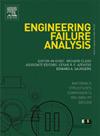A metallurgical failure analysis of mTBM disc cutters under hard rock excavation
IF 5.7
2区 工程技术
Q1 ENGINEERING, MECHANICAL
引用次数: 0
Abstract
Predicting wear in Tunnel Boring Machine (TBM) disc cutters remains a complex challenge due to extreme operational conditions and numerous variables involved in hard rock excavation. This study comprehensively investigates the failure modes and wear mechanisms of mTBM disc cutters, aiming to refine existing wear classifications and improve understanding of the degradation processes. Through a multi-scale approach combining macroscopic visual inspection, optical microscopy (OM), scanning electron microscopy (SEM), microhardness profiling, and X-Ray diffraction (XRD), twelve worn disc cutters from an urban sanitation tunnel were analyzed. Our findings reveal normal/sharpening wear as the most prevalent (58 %), followed by blockage (25 %) and mushrooming (17 %), with distinct distributions based on cutter position. Crucially, microscopic analysis identified the systematic formation of White Etching Layers (WLs) and Dark Layers (DLs) on worn surfaces, where the WL exhibits increased hardness, grain refinement, and a higher content of retained austenite compared to the substrate. Crack nucleation was predominantly observed at the WL/DL interface, a zone of pronounced mechanical property mismatch, leading to progressive material chipping. This observation, supported by detailed microstructural evidence, challenges previous interpretations that dismiss sliding contact in field conditions, strongly suggesting a hybrid rolling-sliding contact mode at the rock-cutter interface. The study underscores the critical role of these subsurface microstructural changes in cutter degradation, advocating for a refined wear classification that incorporates these mechanisms. These insights are vital for optimizing TBM cutter design and enhancing durability under severe excavation conditions.
mTBM盘式切割机在硬岩开挖下的冶金失效分析
由于隧道掘进机(TBM)盘式刀具的极端工作条件和涉及硬岩开挖的众多变量,预测盘式刀具的磨损仍然是一项复杂的挑战。本研究全面研究了mTBM圆盘刀具的失效模式和磨损机理,旨在完善现有的磨损分类,提高对退化过程的理解。通过宏观目视检查、光学显微镜(OM)、扫描电镜(SEM)、显微硬度分析和x射线衍射(XRD)等多尺度方法,对某城市卫生隧道中12把磨损的圆盘刀具进行了分析。我们的研究结果显示,正常/锐化磨损是最普遍的(58%),其次是堵塞(25%)和蘑菇状(17%),根据刀具位置有不同的分布。至关重要的是,显微分析确定了磨损表面上系统形成的白色蚀刻层(WLs)和深色蚀刻层(DLs),与基体相比,WL表现出更高的硬度、晶粒细化和更高的残余奥氏体含量。裂纹形核主要出现在WL/DL界面,这是一个力学性能明显不匹配的区域,导致材料逐渐切屑。这一观察结果得到了详细的微观结构证据的支持,挑战了之前对现场条件下滑动接触的解释,强烈表明岩石切割器界面存在混合滚动-滑动接触模式。该研究强调了这些地下微观结构变化在刀具降解中的关键作用,提倡将这些机制纳入精细磨损分类。这些见解对于优化TBM刀具设计和提高恶劣开挖条件下的耐久性至关重要。
本文章由计算机程序翻译,如有差异,请以英文原文为准。
求助全文
约1分钟内获得全文
求助全文
来源期刊

Engineering Failure Analysis
工程技术-材料科学:表征与测试
CiteScore
7.70
自引率
20.00%
发文量
956
审稿时长
47 days
期刊介绍:
Engineering Failure Analysis publishes research papers describing the analysis of engineering failures and related studies.
Papers relating to the structure, properties and behaviour of engineering materials are encouraged, particularly those which also involve the detailed application of materials parameters to problems in engineering structures, components and design. In addition to the area of materials engineering, the interacting fields of mechanical, manufacturing, aeronautical, civil, chemical, corrosion and design engineering are considered relevant. Activity should be directed at analysing engineering failures and carrying out research to help reduce the incidences of failures and to extend the operating horizons of engineering materials.
Emphasis is placed on the mechanical properties of materials and their behaviour when influenced by structure, process and environment. Metallic, polymeric, ceramic and natural materials are all included and the application of these materials to real engineering situations should be emphasised. The use of a case-study based approach is also encouraged.
Engineering Failure Analysis provides essential reference material and critical feedback into the design process thereby contributing to the prevention of engineering failures in the future. All submissions will be subject to peer review from leading experts in the field.
 求助内容:
求助内容: 应助结果提醒方式:
应助结果提醒方式:


